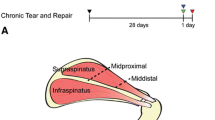Abstract
Purpose
The aim of the present study was to assess the function of the isolated muscle component in retracted rotator cuff tears.
Methods
Muscle biopsies were harvested from the supraspinatus and the ipsilateral deltoid in seven patients undergoing surgery for a large, retracted rotator cuff tear. Single fibres and fibre bundles were subjected to passive stretching in vitro with subsequent recordings of tension and sarcomere lengths using the laser diffraction technique. Stress–strain curves were plotted, and the elastic modulus was calculated for all preparations. Morphology was evaluated with regard to collagen fraction, ratio between fast and slow fibres, fibre size and fibre size variability using standard staining techniques.
Results
Intra-individual comparisons of the stress–strain curves showed a high degree of conformity in terms of both shape and tangent values, and there were no statistically significant differences in the elastic modulus for single fibres and bundles in the deltoid and supraspinatus muscles, respectively, supported by the analysis of the observed confidence interval of the differences between the paired values of the elastic modulus. There were no differences in collagen content, fibre size and ratio between fast and slow fibres in the deltoid and supraspinatus muscles, respectively.
Conclusion
We conclude that muscle biopsies from the supraspinatus in retracted rotator cuff tears respond normally to mechanical testing in vitro.


Similar content being viewed by others
References
Ashry R, Schweitzer ME, Cunningham P, Cohen J, Babb J, Cantos A (2007) Muscle atrophy as a consequence of rotator cuff tears: should we compare the muscles of the rotator cuff with those of the deltoid? Skeletal Radiol 36:841–845
Cofield RH, Parvizi J, Hoffmeyer PJ, Lanzer WL, Ilstrup DM, Rowland CM (2001) Surgical repair of chronic rotator cuff tears. A prospective long-term study. J Bone Joint Surg Am 83-A:71–77
Einarsson F, Runesson E, Fridén J (2008) Passive mechanical features of single fibers from human muscle biopsies – effects of storage. J Orthop Surg Res 3:22
Fuchs B, Gilbart MK, Hodler J, Gerber C (2006) Clinical and structural results of open repair of an isolated one-tendon tear of the rotator cuff. J Bone Joint Surg Am 88:309–316
Fuchs B, Weishaupt D, Zanetti M, Hodler J, Gerber C (1999) Fatty degeneration of the muscles of the rotator cuff: assessment by computed tomography versus magnetic resonance imaging. J Shoulder Elbow Surg 8:599–605
Gerber C, Meyer DC, Schneeberger AG, Hoppeler H, von Rechenberg B (2004) Effect of tendon release and delayed repair on the structure of the muscles of the rotator cuff: an experimental study in sheep. J Bone Joint Surg Am 86-A:1973–1982
Goutallier D, Postel JM, Bernageau J, Lavau L, Voisin MC (1994) Fatty muscle degeneration in cuff ruptures. Pre- and postoperative evaluation by CT scan. Clin Orthop Relat Res 304:78–83
Goutallier D, Postel JM, Gleyze P, Leguilloux P, Van Driessche S (2003) Influence of cuff muscle fatty degeneration on anatomic and functional outcomes after simple suture of full-thickness tears. J Shoulder Elbow Surg 12:550–554
Irlenbusch U, Gansen HK (2003) Muscle biopsy investigations on neuromuscular insufficiency of the rotator cuff: a contribution to the functional impingement of the shoulder joint. J Shoulder Elbow Surg 12:422–426
Melis B, Nemoz C, Walch G (2009) Muscle fatty infiltration in rotator cuff tears: descriptive analysis of 1688 cases. Orthop Traumatol Surg Res 95:319–324
Meyer DC, Hoppeler H, von Rechenberg B, Gerber C (2004) A pathomechanical concept explains muscle loss and fatty muscular changes following surgical tendon release. J Orthop Res 22:1004–1007
Meyer DC, Pirkl C, Pfirrmann CW, Zanetti M, Gerber C (2005) Asymmetric atrophy of the supraspinatus muscle following tendon tear. J Orthop Res 23:254–258
Safran O, Derwin KA, Powell K, Iannotti JP (2005) Changes in rotator cuff muscle volume, fat content, and passive mechanics after chronic detachment in a canine model. J Bone Joint Surg Am 87:2662–2670
Shen PH, Lien SB, Shen HC, Lee CH, Wu SS, Lin LC (2008) Long-term functional outcomes after repair of rotator cuff tears correlated with atrophy of the supraspinatus muscles on magnetic resonance images. J Shoulder Elbow Surg 17:1S–7S
Acknowledgments
This study was supported by grants from Elin and Carl Linders Foundation, Sweden.
Author information
Authors and Affiliations
Corresponding author
Rights and permissions
About this article
Cite this article
Einarsson, F., Runesson, E., Karlsson, J. et al. Muscle biopsies from the supraspinatus in retracted rotator cuff tears respond normally to passive mechanical testing: a pilot study. Knee Surg Sports Traumatol Arthrosc 19, 503–507 (2011). https://doi.org/10.1007/s00167-010-1284-0
Received:
Accepted:
Published:
Issue Date:
DOI: https://doi.org/10.1007/s00167-010-1284-0




